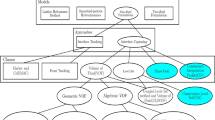Abstract
To model the thermal interaction between two Lennard–Jones particles, we propose a few small modifications to the Lowe–Andersen thermostat, a well-known numerical thermostat that acts on selected pairs of particles. The simulation procedure suggested here is local and easy to implement, while retaining excellent temperature control even at low densities. But more importantly, it is no longer necessary to carry out and additional simulation just to determine the optimal value for the thermostat interaction radius and instead this value is computed directly during the main computer simulation. Because the thermostat is tailored to suit the rather popular Lennard–Jones potential we expect a widespread applicability of the thermal mechanism presented here.

Similar content being viewed by others
References
Allen MP, Tildesley DJ (1987) Computer simulations of liquids. Oxford Science Publications, Oxford
Andersen HC (1980) Molecular dynamics simulations at constant pressure and/or temperature. J Chem Phys 72:2384
Español P, Warren PB (1995) Statistical mechanics of dissipative particle dynamics. Europhys Lett 30:191
Frenkel D, Smit B (2002) Understanding molecular simulations: from algorithms to applications, 2nd edn. Academic Press, Cambridge
Haile JM (1992) Molecular dynamics simulation: elementary methods. Wiley, New York
Hoogerbrugge PJ, Koelman JVAM (1993) Simulating microscopic hydrodynamic phenomena with dissipative particle dynamics. Europhys Lett 19:155
Koopman EA, Lowe CP (2006) Advantages of a Lowe–Andersen thermostat in molecular dynamics simulations. J Chem Phys 124:204103
Lowe CP (1999) An alternative approach to dissipative particle dynamics. Europhys Lett 47:145
Roy S, Das SK (2015) Study of critical dynamics in fluids via molecular dynamics in canonical ensemble. Eur Phys J E 38:132
Ruiz-Franco J, Rovigatti L, Zaccarelli E (2018) On the effect of the thermostat in non-equilibrium molecular dynamics simulations. Eur Phys J E 41:80
Stoyanov SD, Groot RD (2005) From molecular dynamics to hydrodynamics—a novel Galilean invariant thermostat. J Chem Phys 122:114112
Verbeek MG (2019) A modified Lowe–Andersen thermostat for a hard sphere fluid. Eur Phys J E 42:60
Author information
Authors and Affiliations
Corresponding author
Additional information
Publisher's Note
Springer Nature remains neutral with regard to jurisdictional claims in published maps and institutional affiliations.
Rights and permissions
About this article
Cite this article
Verbeek, M.G. A modified Lowe–Andersen thermostat for a Lennard–Jones fluid. Microfluid Nanofluid 25, 8 (2021). https://doi.org/10.1007/s10404-020-02404-9
Received:
Accepted:
Published:
DOI: https://doi.org/10.1007/s10404-020-02404-9




